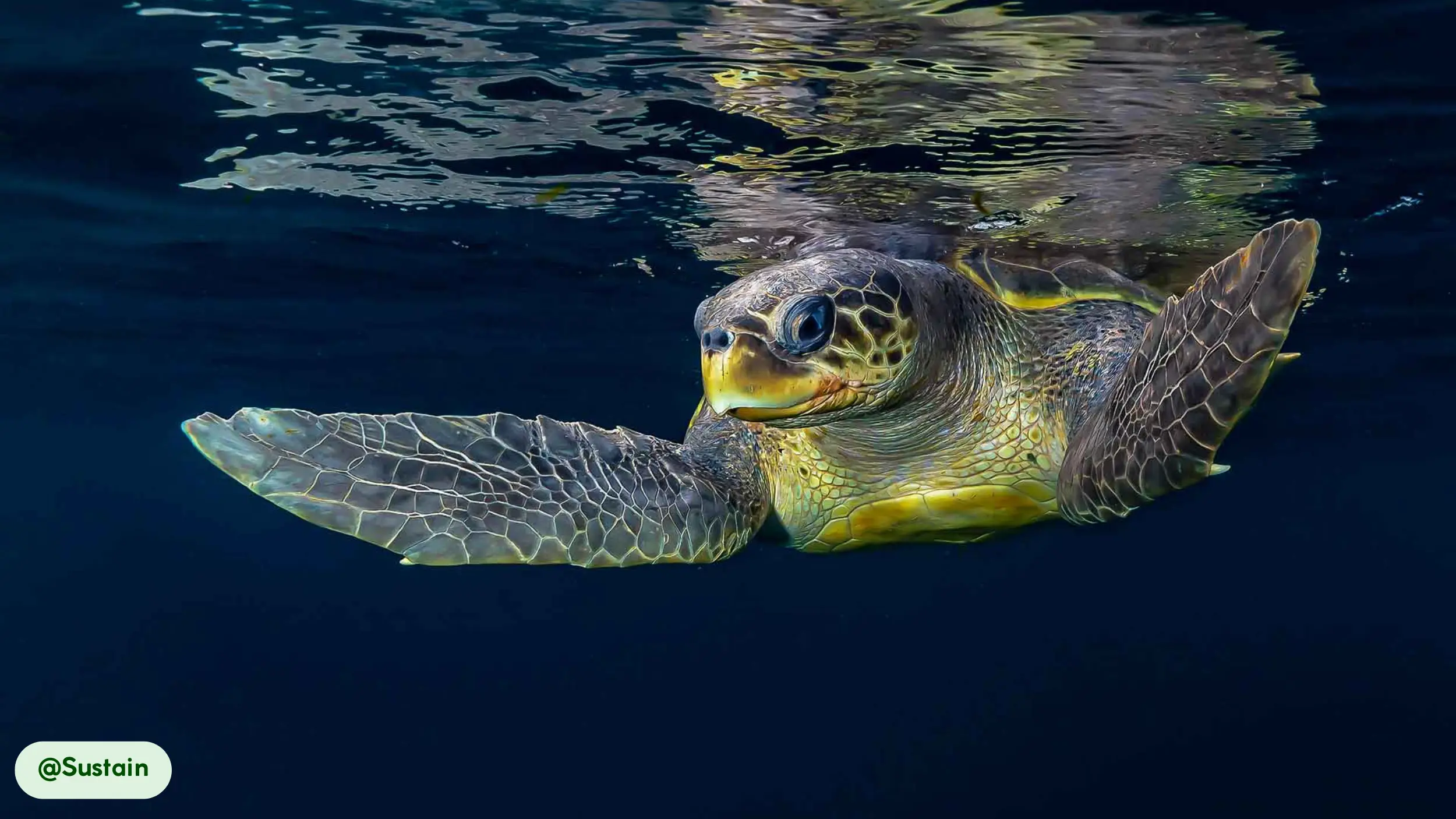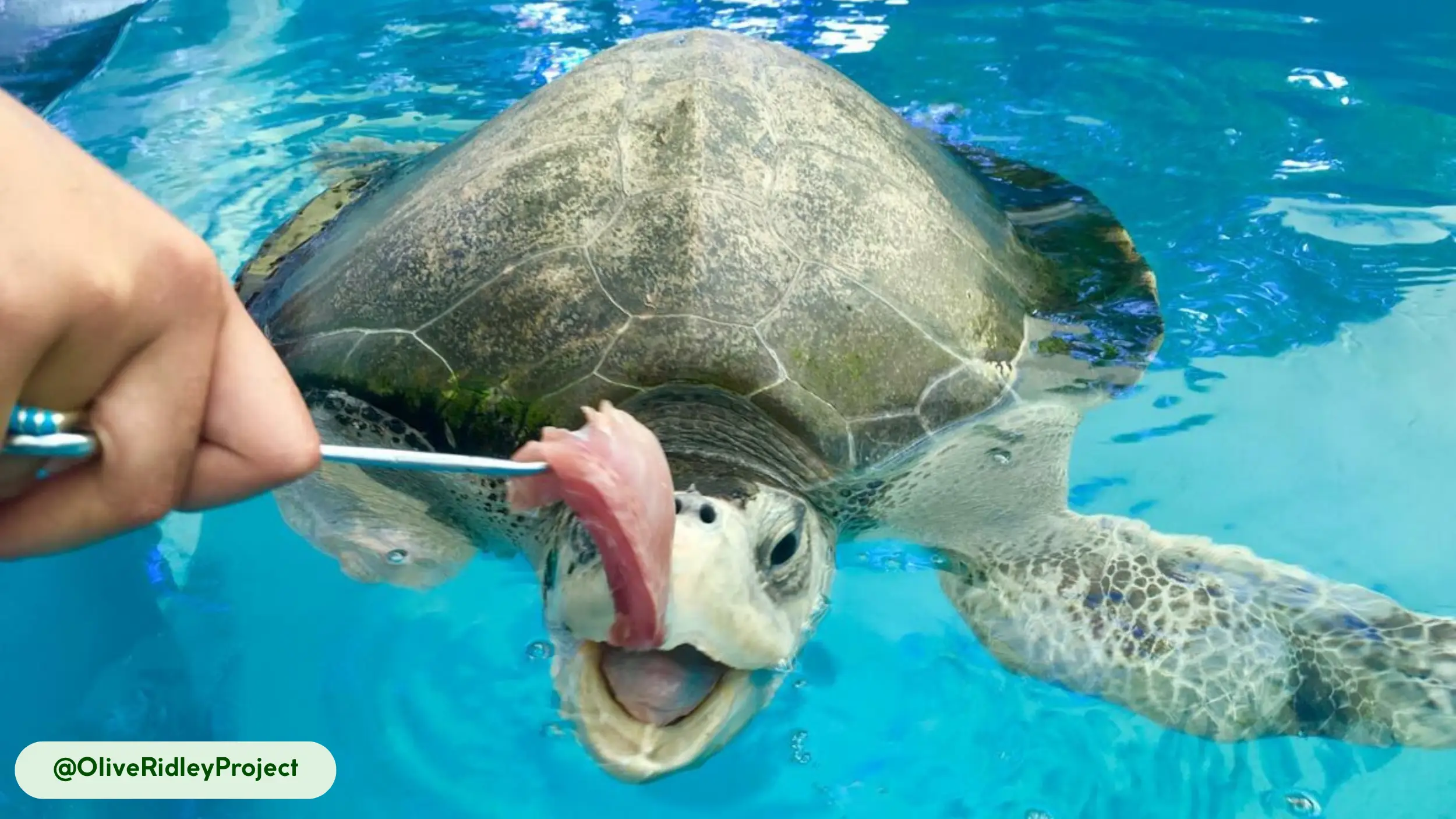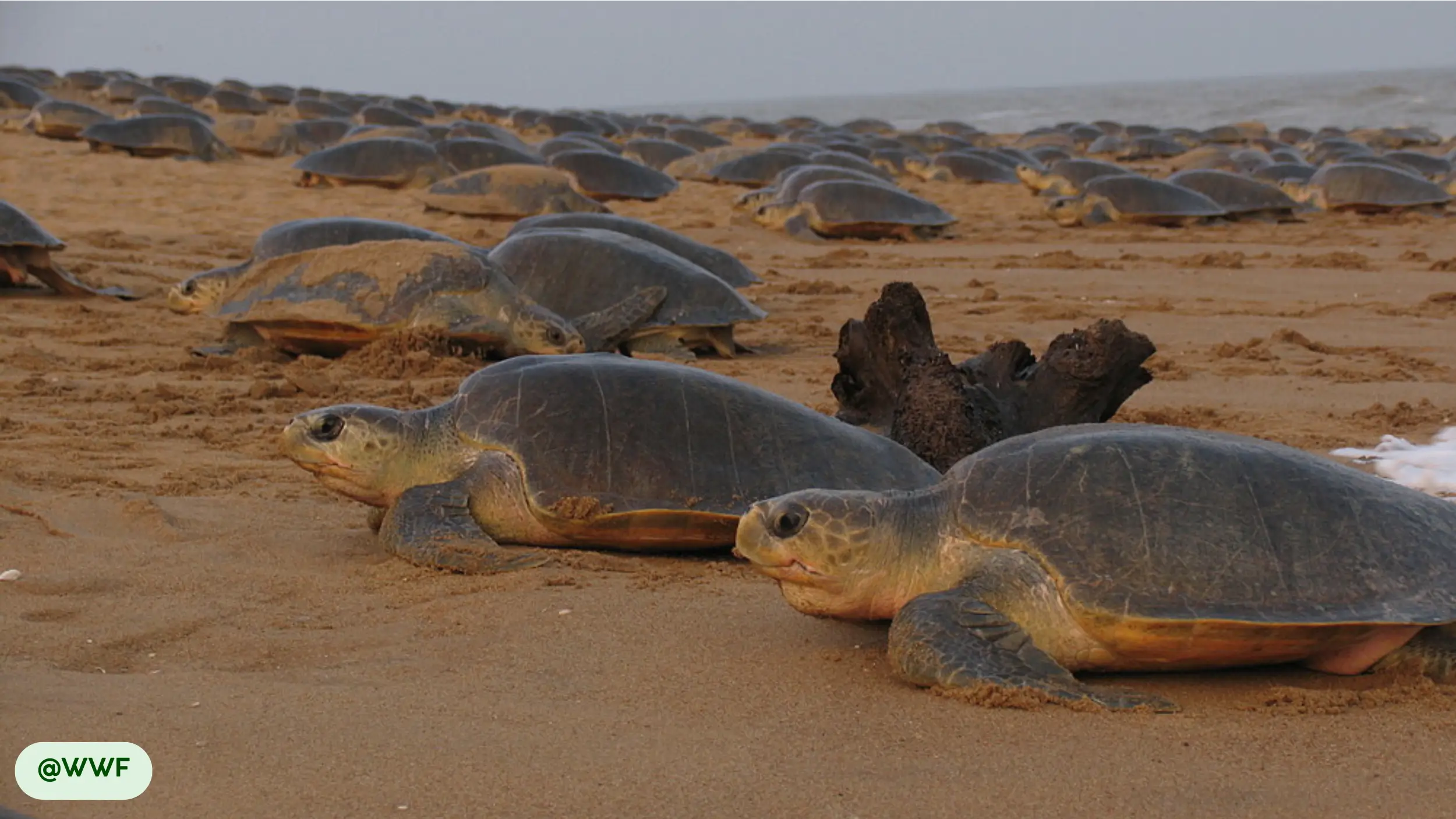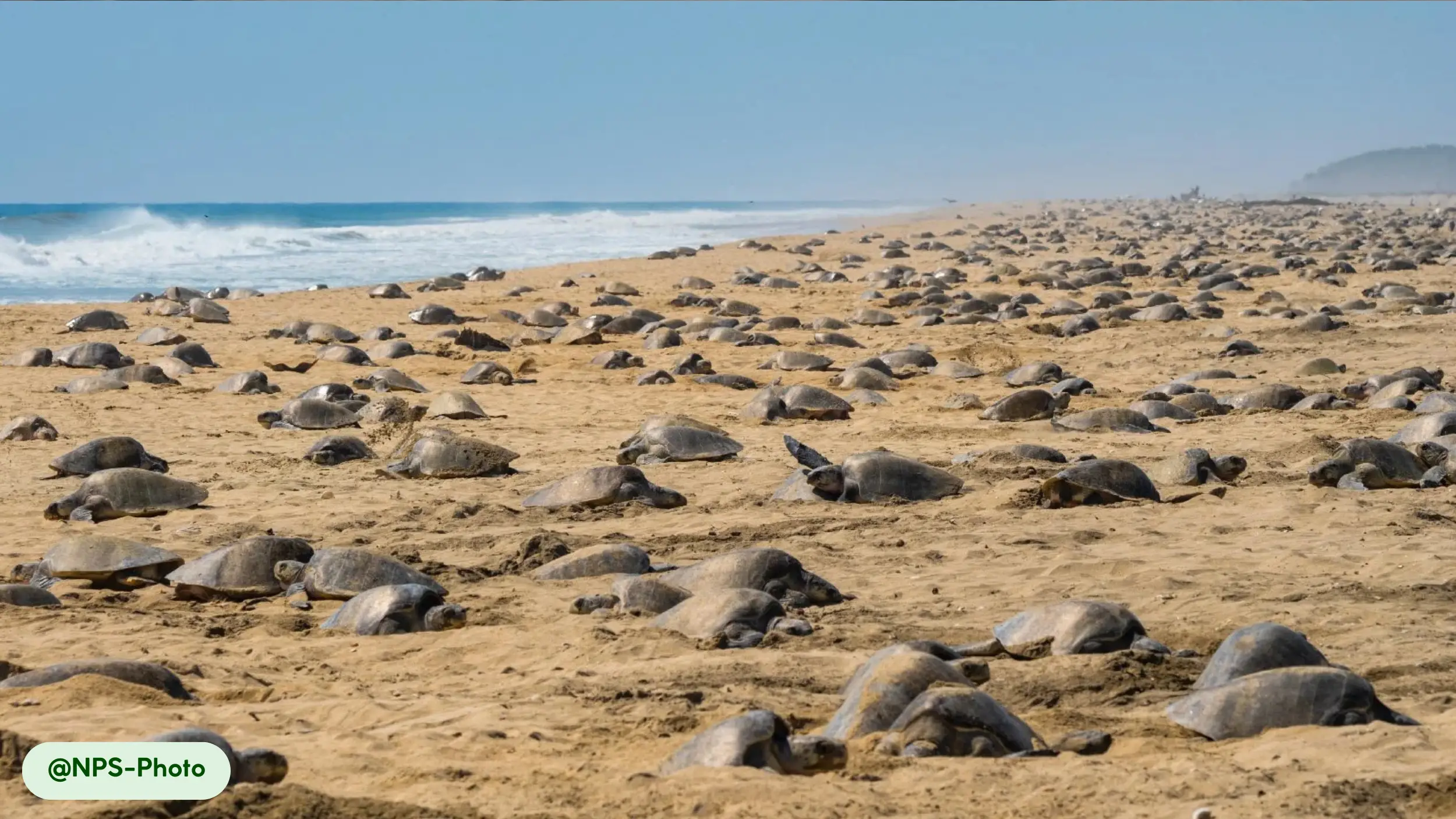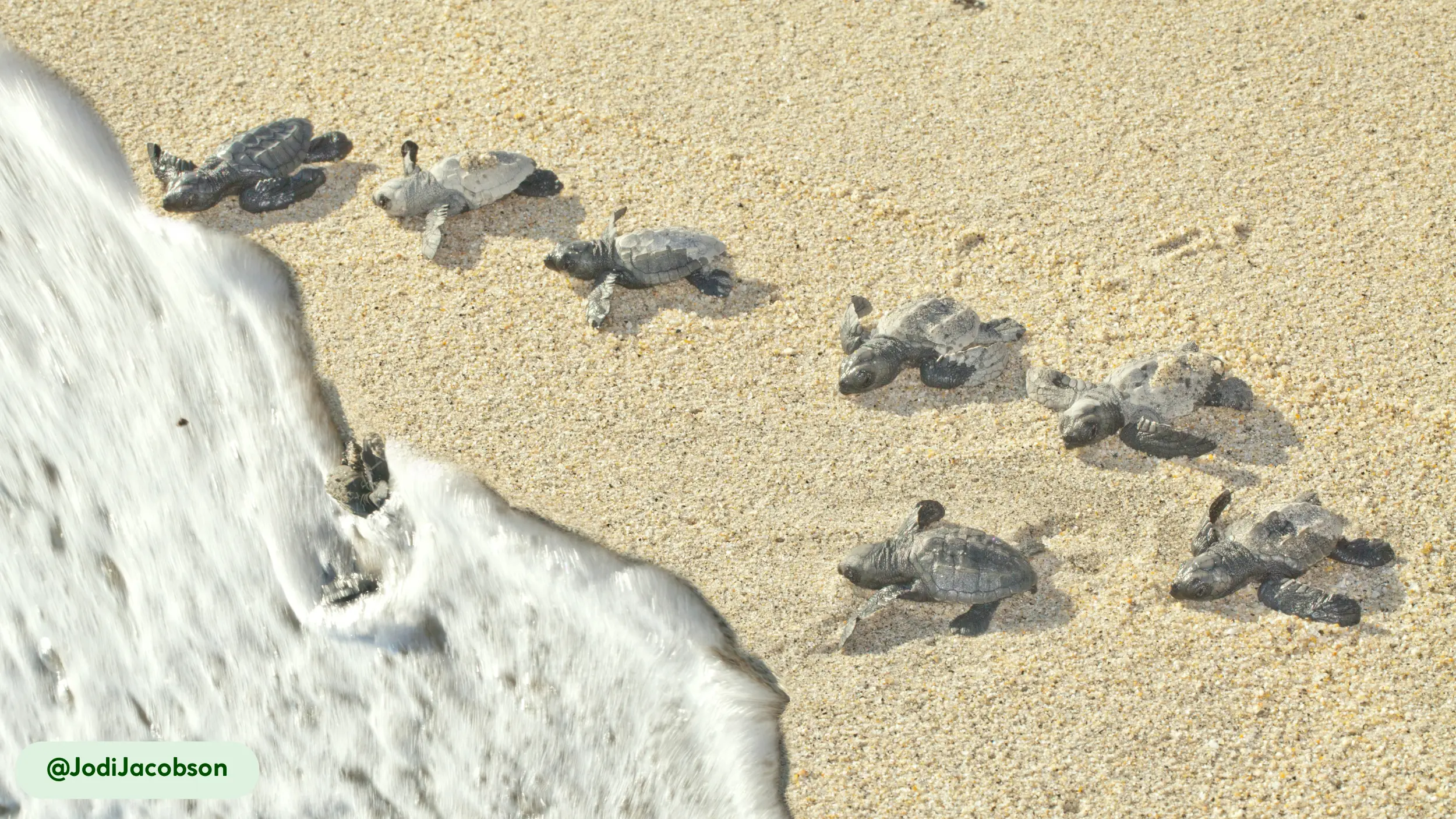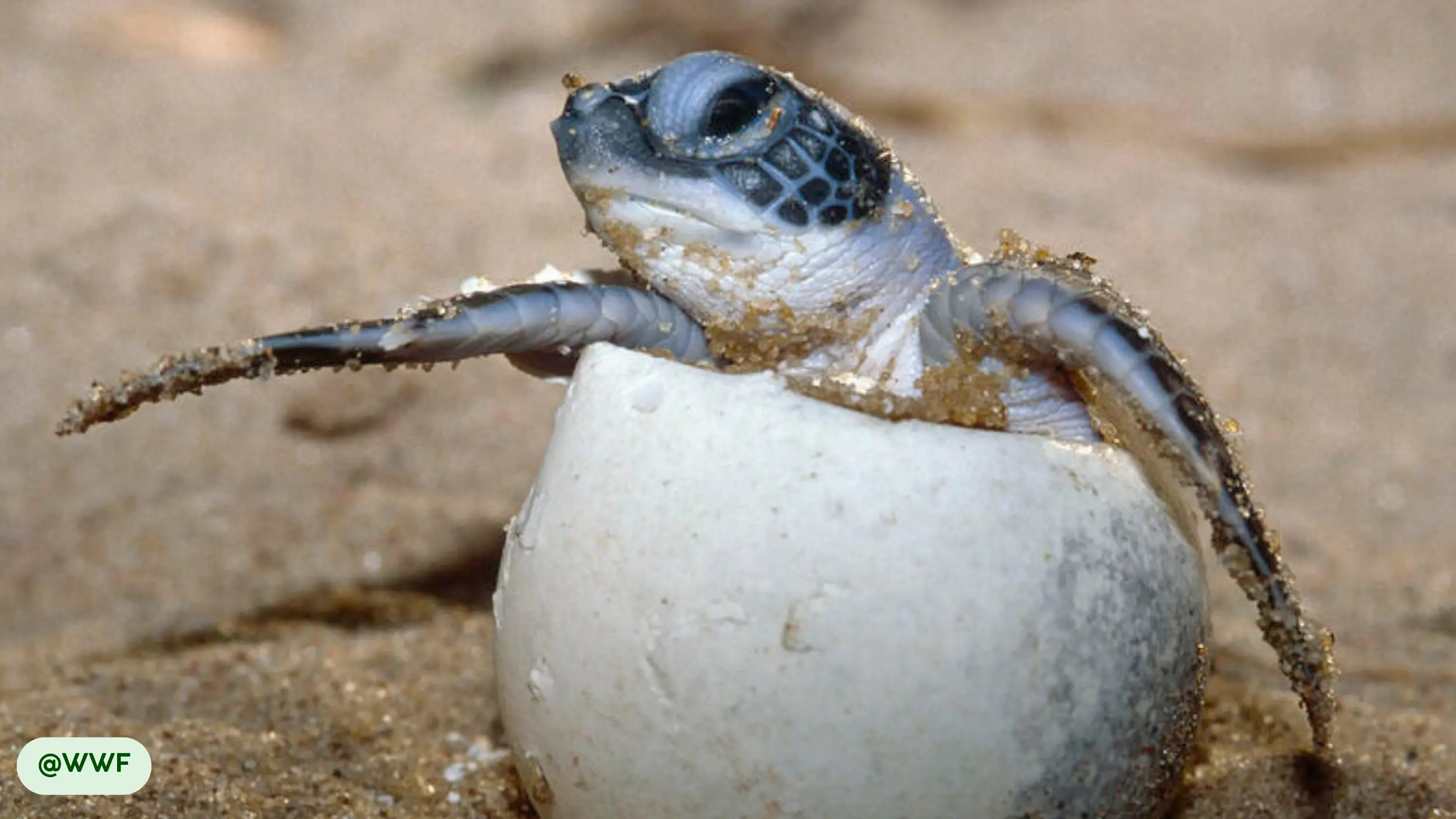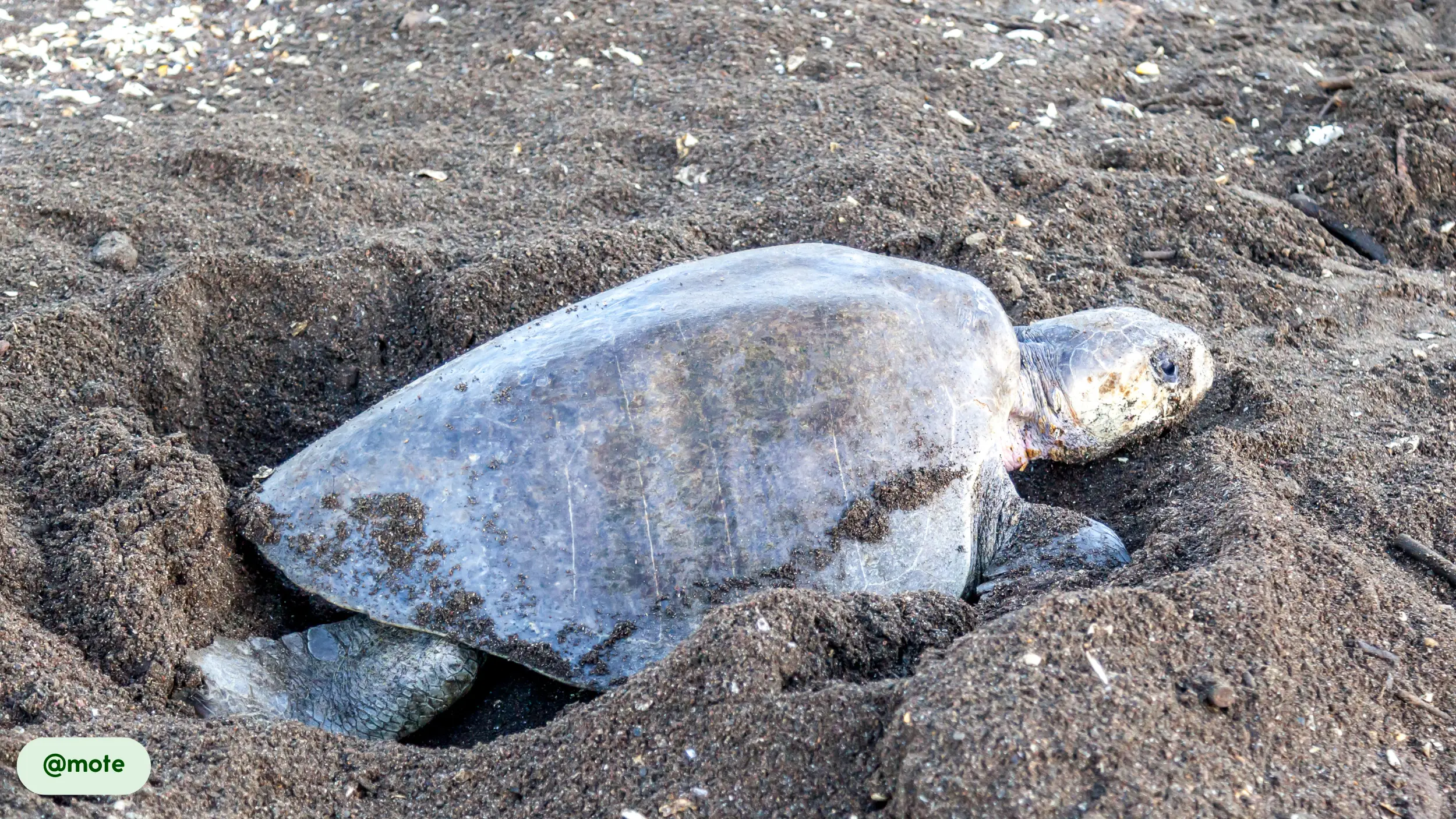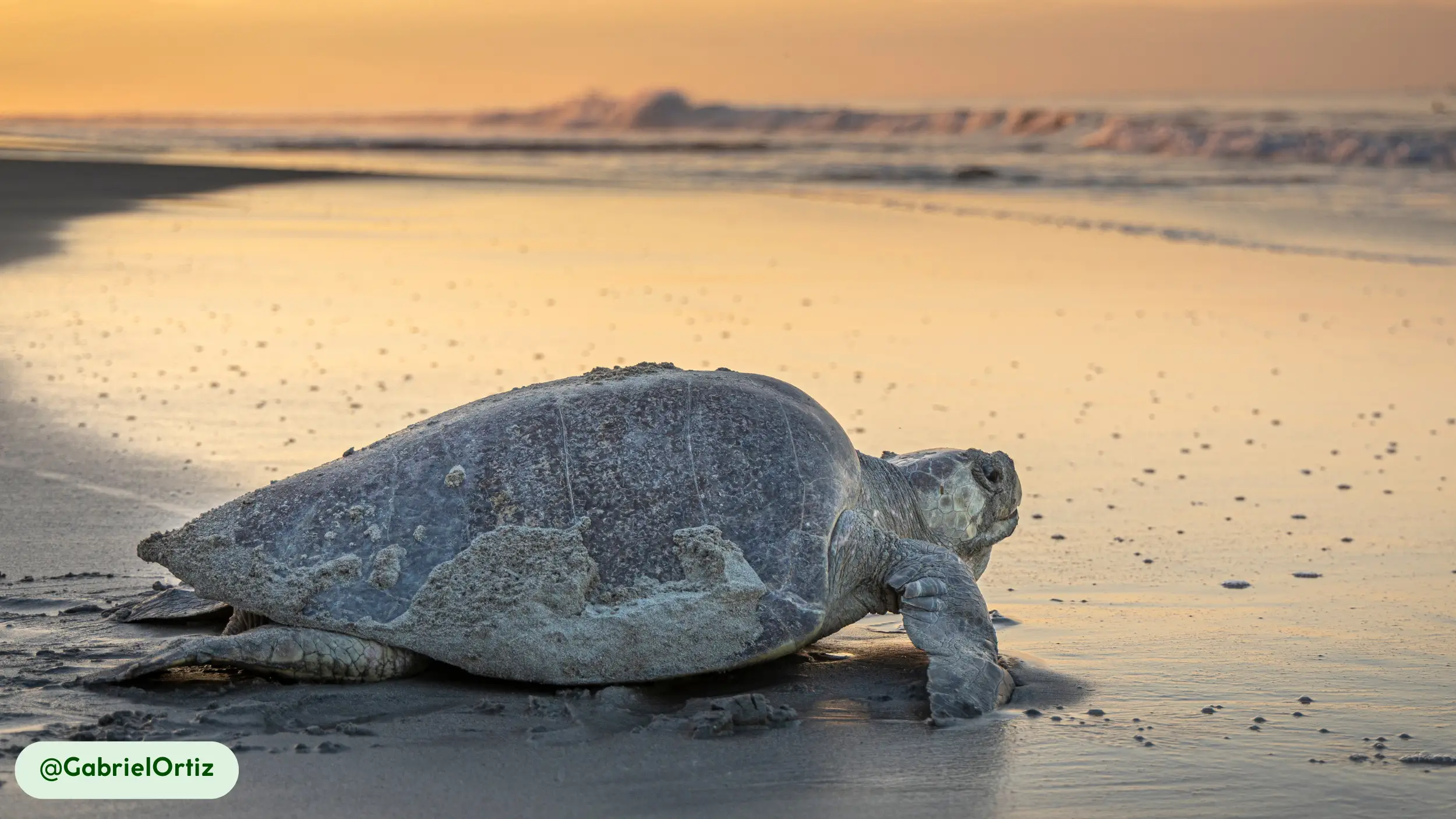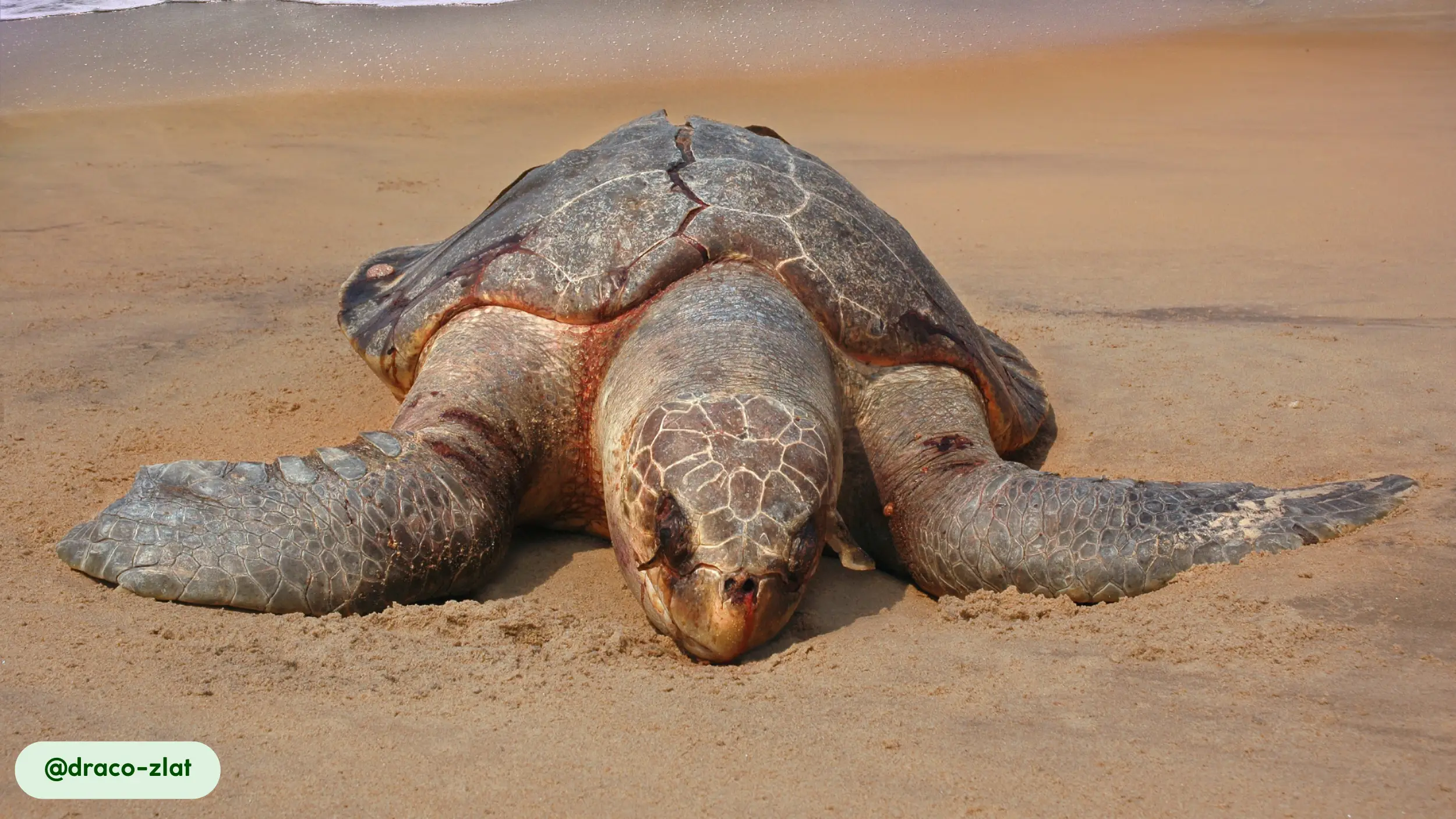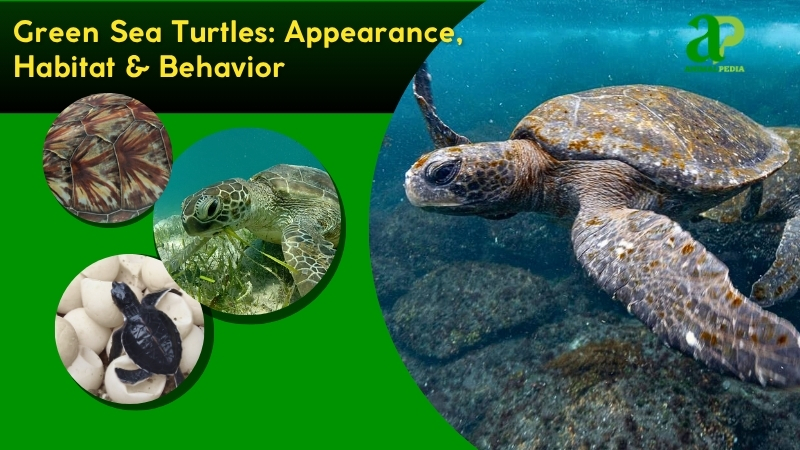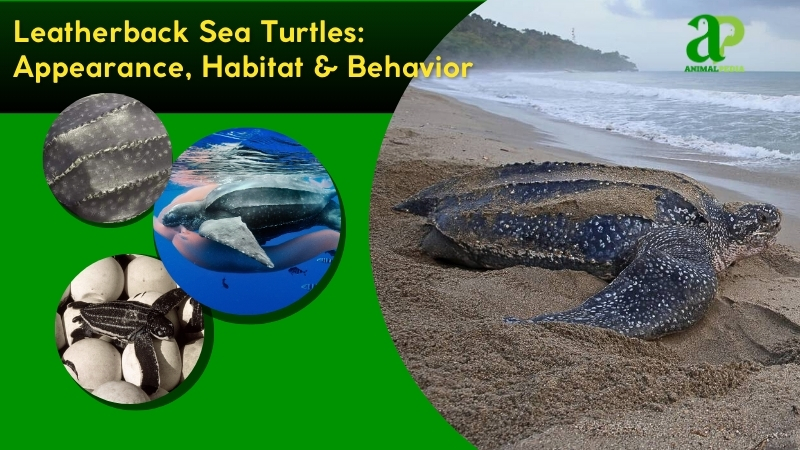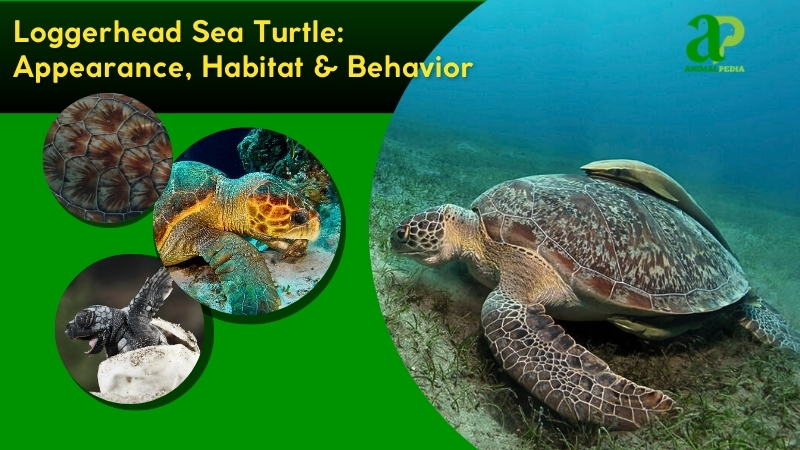Olive Ridley sea turtles (Lepidochelys olivacea) are a reptile species of the family Cheloniidae, distinguished by their streamlined body and heart-shaped carapace [10, 11]. Adult turtles typically measure between 24 and 28 inches (61-70 cm) in carapace length and weigh 80 to 110 lbs (36-50 kg) [10, 11, 16].
These animals are found in the tropical waters of the Pacific, Indian, and Atlantic oceans, where they feed on jellyfish, crabs, and shrimp [2, 18]. They are capable of feats of movement, swimming at top speeds of 22 mph (35 km/h) and migrating thousands of miles between feeding and nesting grounds [6, 11]. The species is best known for its unique, synchronized mass nesting behavior, known as an arribada [6].
This guide provides a detailed examination of the Olive Ridley’s biology, habitat, and behaviors. We will analyze the species’ scientific classification and physical characteristics, from its unique carapace to its specialized flippers. The content also addresses its ecological role and interactions with humans. A key focus is the spectacular arribada phenomenon, exploring its origins and importance for survival.
This information is intended to foster a deeper understanding of this vital marine species and the conservation efforts protecting its future. The Olive Ridley is defined by its unique features and behaviors. Understanding what the species is and how it is scientifically classified is the first step in appreciating its place in the world.
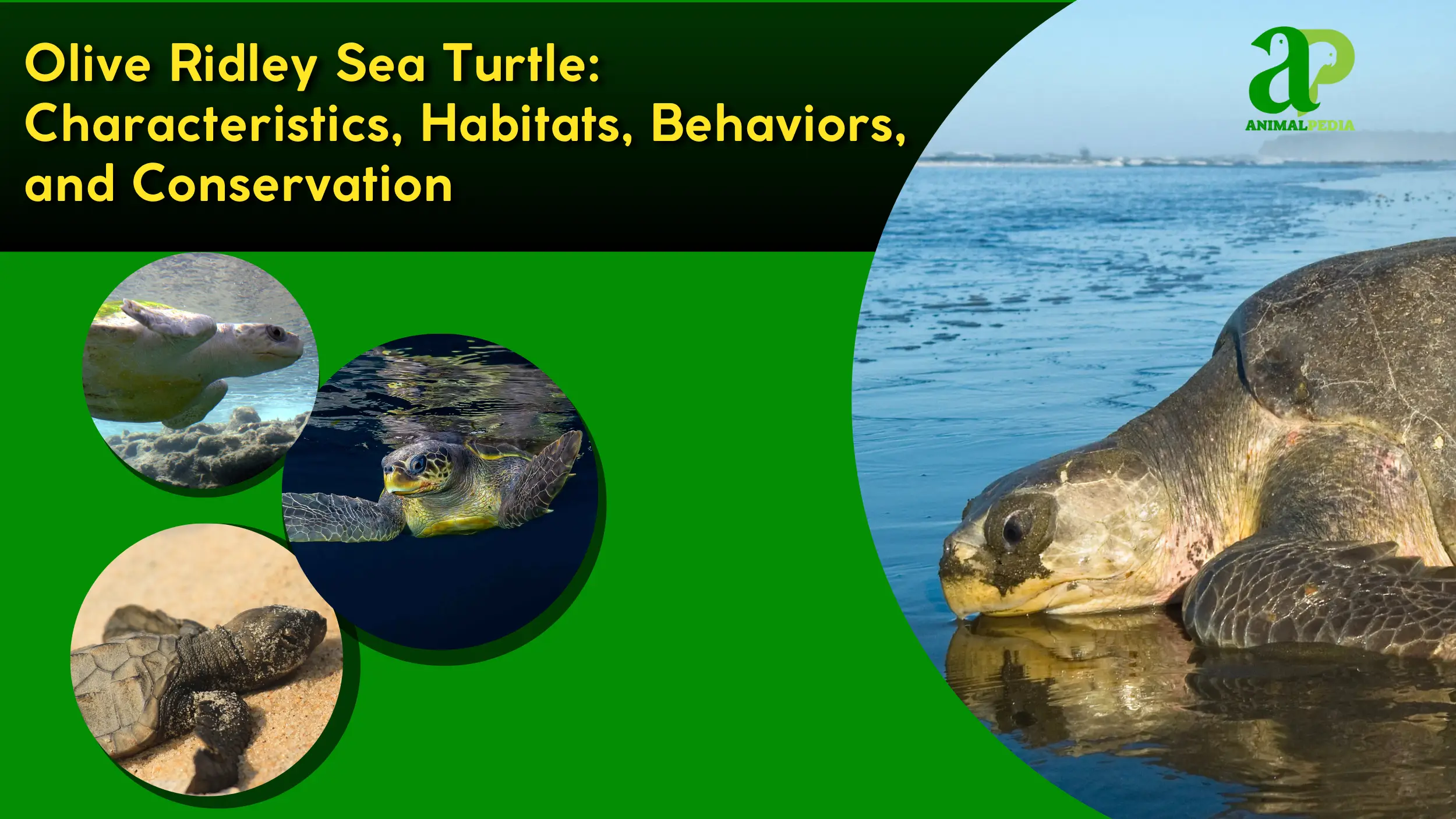
What Are Olive Ridley Sea Turtles?
An Olive Ridley sea turtle (Lepidochelys olivacea) is a species of marine reptile characterized by its moderate size, global distribution across three major oceans, and a distinctive olive-green carapace [10, 11]. The species belongs to the family Cheloniidae, which includes hard-shelled sea turtles, and is classified under the order Testudines, class Reptilia, and phylum Chordata [5, 8, 10].
Its scientific name reflects its defining characteristics. Lepidochelys combines the Greek words for “scale” and “turtle,” while olivacea is Latin for “olive-colored,” referring to its characteristic hue [8, 10]. This species is also known by other common names, such as the Pacific Ridley turtle and Golfina, with the latter being a Spanish term meaning “little olive” that alludes to the turtle’s coloration and diminutive size [8, 10, 11].
This species exhibits a unique reproductive strategy. A 2024 study in Endangered Species Research found that Olive Ridley turtles in Costa Rica employ an “income breeding” strategy, feeding during the breeding season to maintain energy for their mass nesting events, a behavior distinct from other turtles that rely on stored fat [9].
The scientific community debates whether different populations of Olive Ridleys, such as those in the Pacific and Indian Oceans, should be designated as subspecies. Genetic studies indicate distinct populations [5], but others cite consistent physical characteristics across regions, challenging the need for separate classifications [8].
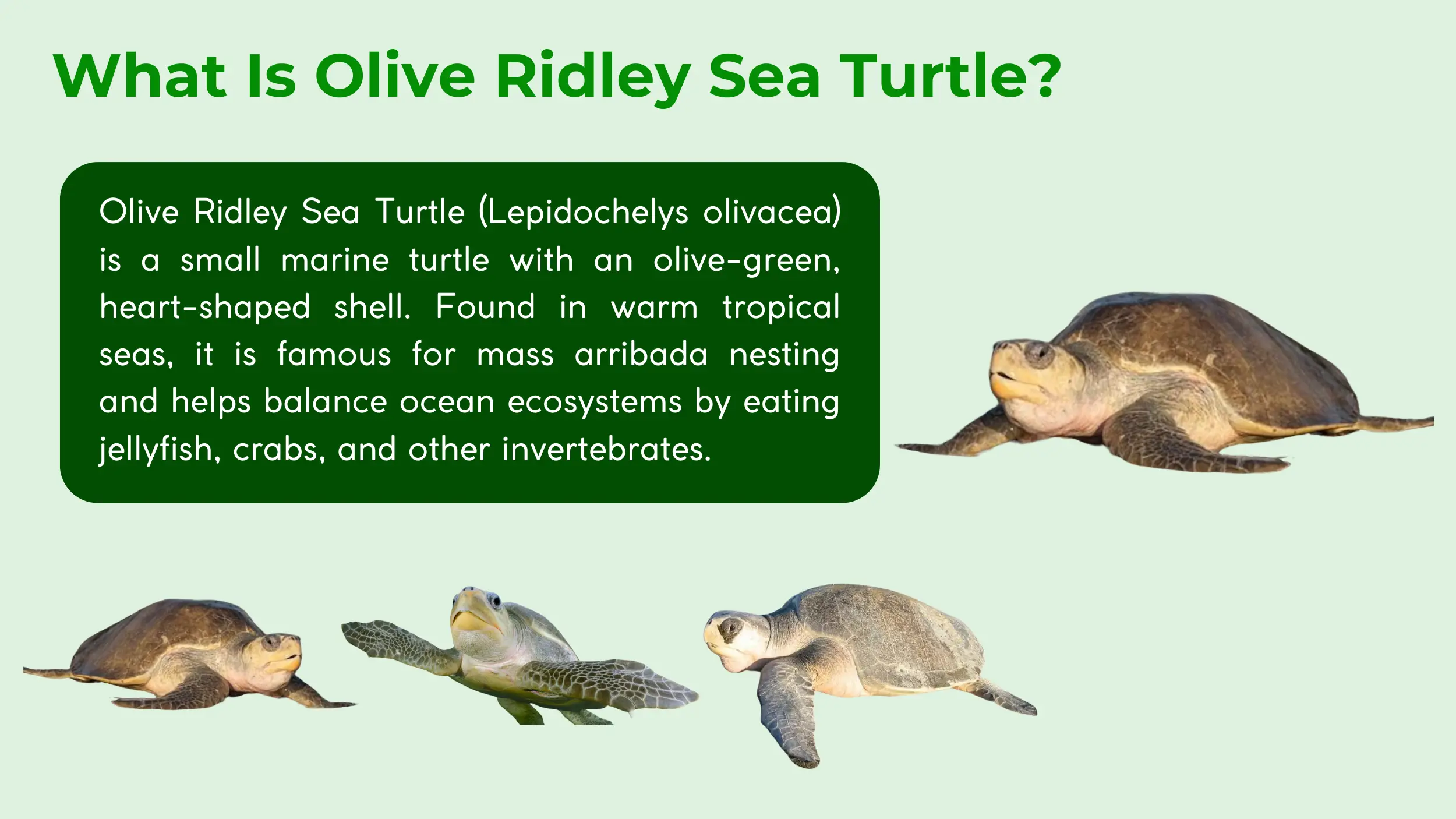
This ongoing scientific discussion highlights the complexity of their taxonomic classification. With their identity established, the physical appearance of these turtles plays a key role in their story. A detailed examination of their anatomy reveals the specialized adaptations that allow them to thrive in the ocean.
What Do Olive Ridley Sea Turtles Look Like?
The Olive Ridley sea turtle is characterized by a streamlined physique, with a smooth, heart-shaped carapace optimized for efficient underwater movement [8, 10]. The name derives from its coloration: the carapace is typically olive-green, which can sometimes appear grayish [10].
This contrasts with the pale, creamy yellow of its plastron, or underside [10]. The smooth carapace lacks distinct patterns but is characterized by a unique number of costal scutes, typically ranging from 5 to 9 pairs, which are often asymmetrical in arrangement [10, 11]. The turtle’s head is small and triangular, and its limbs are specialized for aquatic life [10, 11].
The Olive Ridley possesses several distinctive anatomical features. The following are the most prominent:
- Streamlined Body: The turtle’s overall body shape is a hydrodynamic adaptation that enables it to move through the ocean with minimal resistance [8, 10]. Its small size in relation to other sea turtles contributes to its agile movement [10].
- Specialized Limbs: The four limbs are modified into powerful flippers. The foreflippers are longer and paddle-shaped, propelling the turtle through water. Each flipper possesses one or two claws, used for grasping or digging on land during nesting [10].
- Crushing Jaw: The mouth is a short, beak-like snout, and the horny beak is essential for crushing the hard-shelled prey that constitutes a significant portion of its omnivorous diet [10, 11]. The turtle does not possess teeth [2].
- Nictitating Membrane: The eyes are large and dark brown, equipped with a nictitating membrane that serves as a protective shield for underwater vision, allowing the turtle to navigate its marine habitat effectively [10, 11].
- Defining Carapace: The smooth, olive-green carapace serves as a primary defensive structure, shielding the turtle’s vital organs from predators and environmental stress [10, 11].
Sexual dimorphism is also evident in the species’ physical appearance. Males can be distinguished from females by their slightly concave plastron, which aids in mating, and their longer, thicker tail. Females have a rounder carapace and a shorter tail [10, 11].
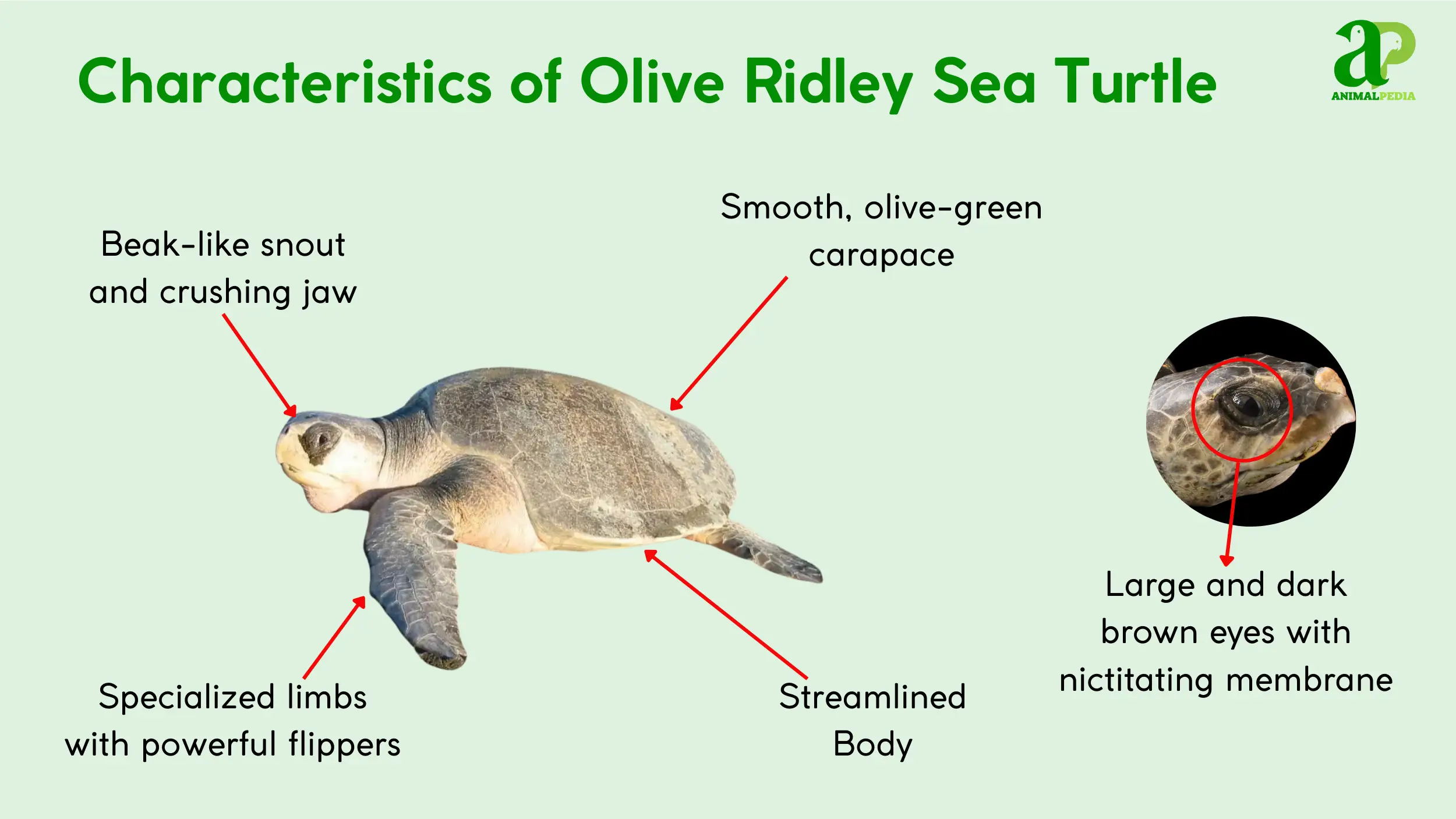
The physical form of the Olive Ridley is perfectly suited for its environment. Now, it’s time to examine the dimensions of these small yet powerful creatures and compare them to other marine animals.
How Big Are Olive Ridley Sea Turtles?
Adult Olive Ridley sea turtles are among the smallest marine turtle species. They have a carapace length of 24 to 28 inches (61-70 cm) and weigh between 80 and 110 lbs (36-50 kg) [10, 11, 16]. While there are minor physical differences between sexes, their size is not a primary indicator.
| Measurement | Males | Females |
| Length | Up to 70 cm | Up to 70 cm |
| Weight | Up to 50 kg | Up to 50 kg |
| Record Size | Minimal difference | Minimal difference |
Hatchlings are quite small, measuring 1.5 to 2 inches (3.8-5 cm) and weighing approximately 0.5 to 1 oz (14-28 g). They are comparable in size to a golf ball. Juveniles grow to between 10 to 15 inches (25-38 cm) and 10 to 30 lbs (4.5-13.6 kg) over the course of 5 to 10 years [2, 11].
Turtles do not reach sexual maturity until they are approximately 15 years of age [2, 11]. The size of these turtles gives us clues about their habits and lifestyle. Their physical form is perfectly suited for the diverse habitats they inhabit, ranging from coastal waters to the vast open ocean.
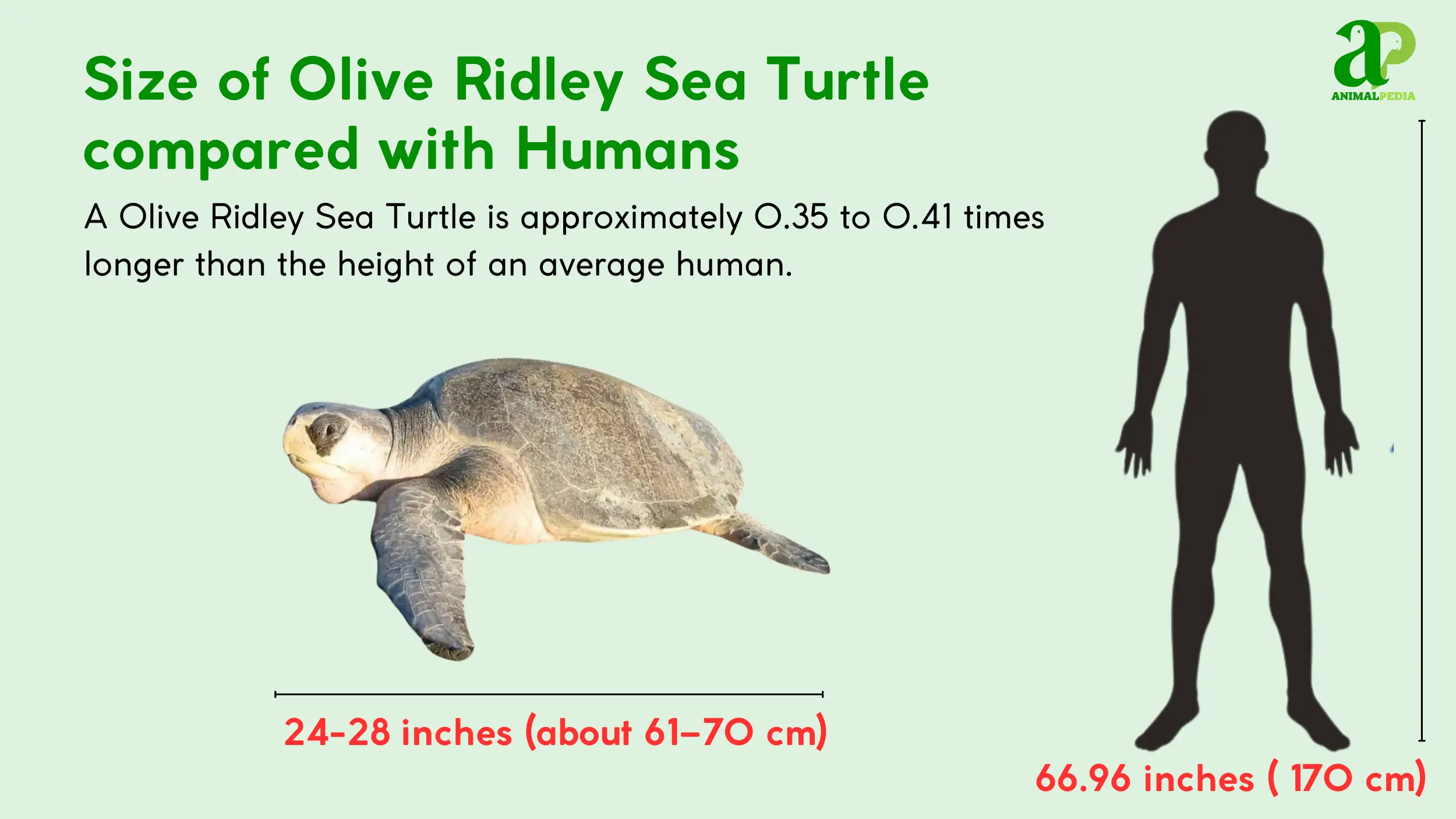
Where Do Olive Ridley Sea Turtles Live?
Olive Ridley sea turtles are globally distributed, inhabiting tropical waters of the Pacific, Indian, and Atlantic oceans [2, 10, 11]. This expansive range spans coastal waters and marine environments across over 80 countries, with key populations in regions such as Mexico, Costa Rica, and India [2, 10]. The species prefers warm coastal waters, shallow bays, and estuaries for foraging, while nesting occurs on sandy beaches [2, 11].
The turtles require specific climatic conditions for survival. They prefer water temperatures between 68 and 86°F (20-30°C) [2]. For nesting, they need humid coastal environments with suitable sand temperatures for successful egg incubation, as temperature determines the sex of the hatchlings [11, 16].
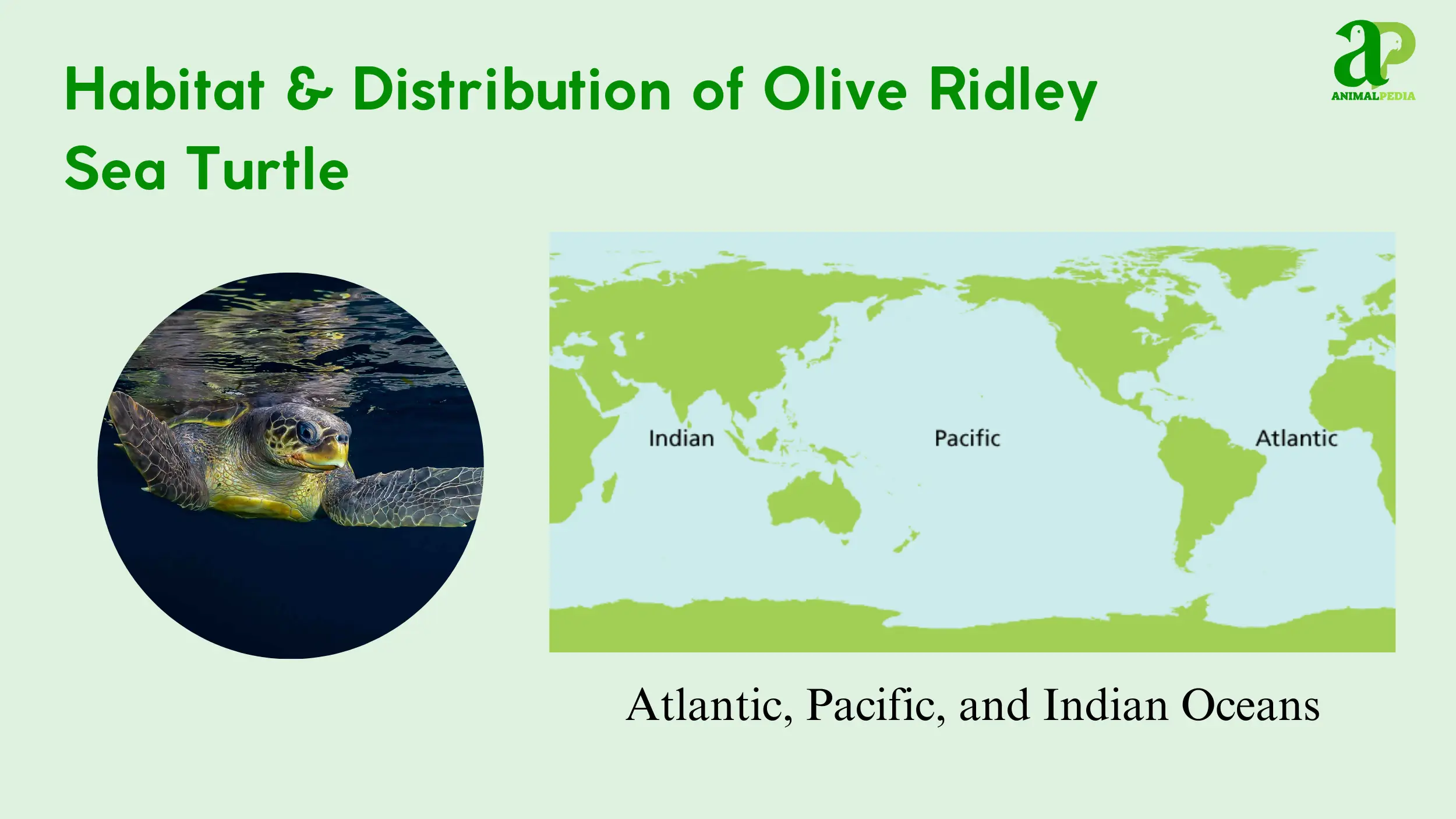
The turtles are non-territorial and often share nesting beaches during arribada events [6]. The global habitats of these turtles are as diverse as their behaviors. The way they interact with their environment, from feeding to migration, offers a deeper understanding of their survival strategies.
How Do Olive Ridley Sea Turtles Behave?
Olive Ridley sea turtles exhibit behaviors characterized by their wide-ranging migratory movements and a unique communal nesting strategy. These animals are highly adapted for a marine existence.
- Diet and Feeding: They are omnivorous foragers that consume a wide variety of prey from the ocean floor.
- Movement and Abilities: These turtles are highly migratory, capable of navigating vast oceanic distances with precision.
- Daily/Seasonal Patterns: Their life cycle is marked by synchronized nesting events and specific activity periods.
These behaviors are essential for their survival and are deeply connected to their environment. A closer look at their diet and movement reveals how they thrive.
Diet and Feeding
Olive Ridley sea turtles are omnivores that consume a variety of small prey. Their diet primarily includes crustaceans, mollusks, tunicates, and shrimp, along with fish and jellyfish [2, 18]. They possess a crushing jaw, a specialized adaptation that enables them to consume hard-shelled organisms on the seafloor, a behavior known as benthic foraging [10].
While their diet is adaptable, a significant portion of their food is derived from the benthic zone [18]. They are active foragers, often hunting near coastal areas and in estuaries [2]. Their feeding patterns are opportunistic, enabling them to capitalize on available food sources in various habitats throughout their migration [11].
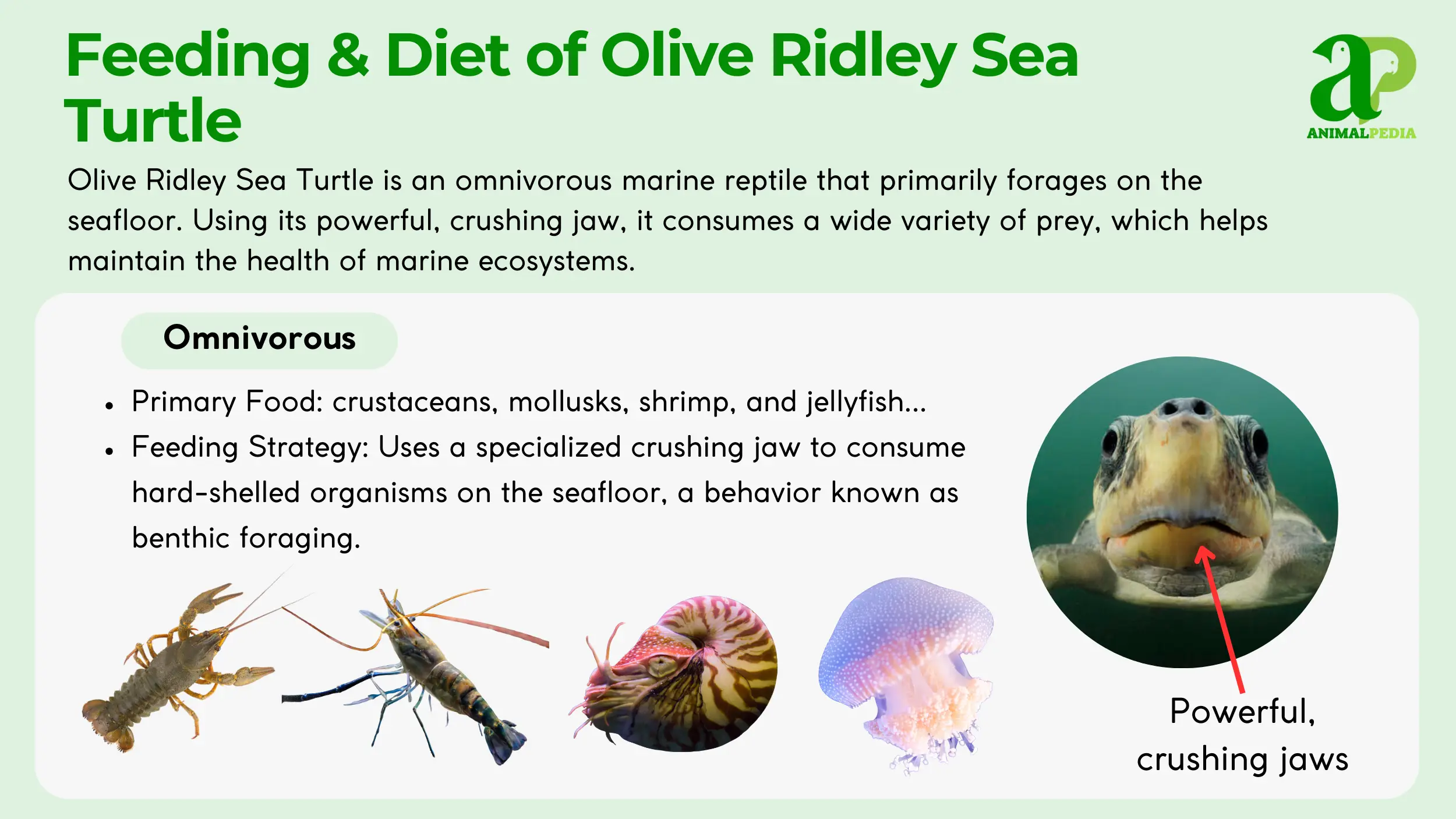
Movement and Abilities
Olive Ridley sea turtles move through water with efficiency. Their primary movement is long-distance migration, covering thousands of miles between feeding and nesting grounds [6, 11].
The turtles’ limbs are paddle-shaped flippers, which enable them to propel through water with great power. Their foreflippers are responsible for forward movement, while their hind flippers are used for steering [10]. This species is also capable of deep diving, often reaching depths of over 500 feet (150 m) to forage for prey on the ocean floor [18].
Olive Ridley turtles can achieve speeds up to 22 mph (35 km/h) in short bursts [11]. Their greatest ability is their navigational precision. Studies indicate they use the Earth’s magnetic field to orient themselves during their extensive migrations [12]. This innate sense allows them to return to the same nesting beaches over generations, a vital skill for species survival [12].
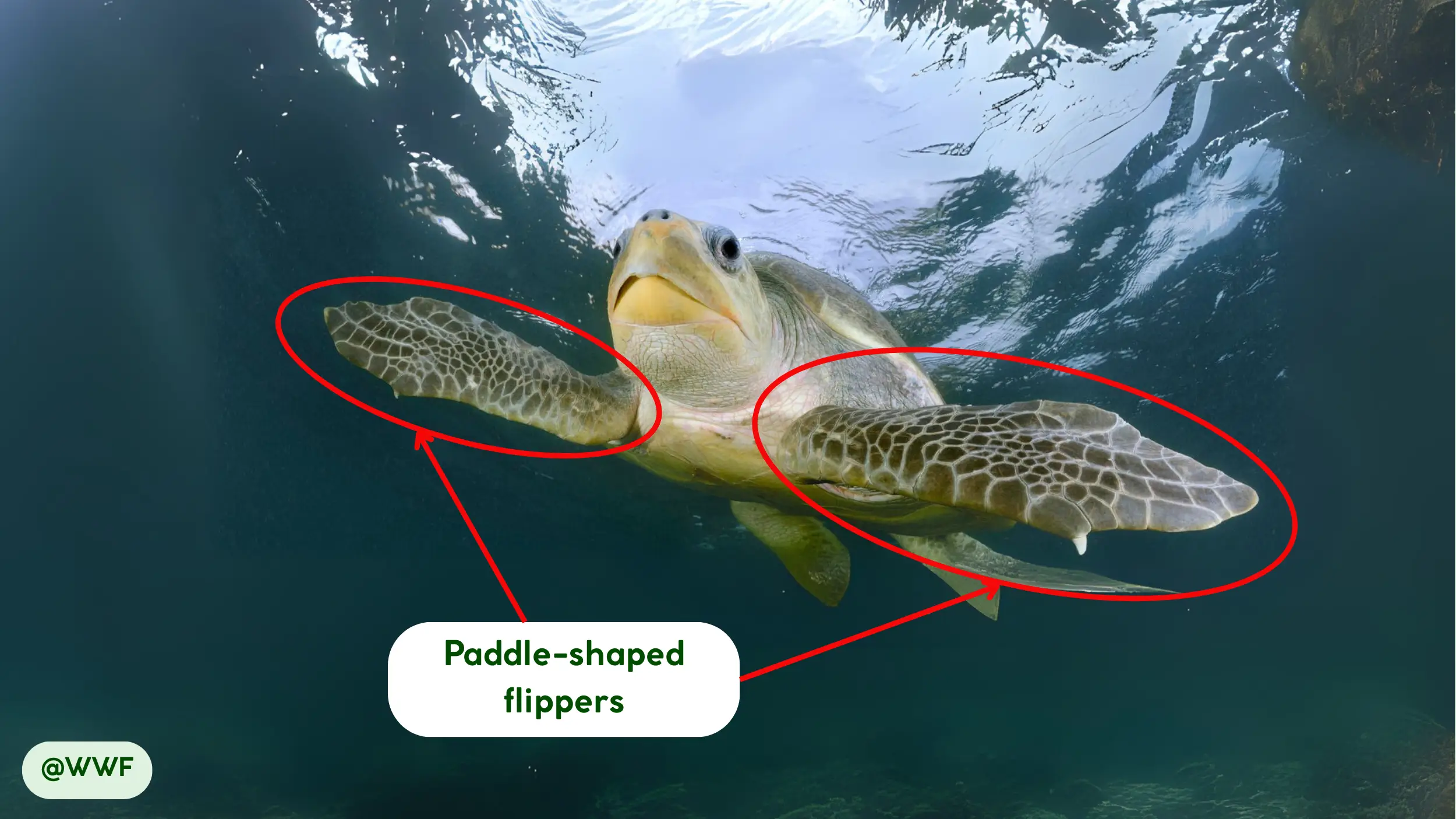
Daily/Seasonal Patterns
Olive Ridley sea turtles do not have a strict daily activity cycle. They are active throughout the day and night, foraging and migrating [10].
Their seasonal patterns are highly defined by their reproductive cycle. The most significant seasonal event is the arribada, a mass nesting event where thousands of females return to specific beaches to lay eggs [6, 16]. This event typically occurs during the rainy season in a few select locations globally, such as in Mexico, Costa Rica, and India [6]. The timing can be influenced by factors like tides and lunar cycles [13].
The migration period for the turtles begins several months before the nesting season. During this time, adults swim from their distant foraging grounds to the coastal waters near the nesting beaches [6]. This journey can be thousands of miles long [11].
After nesting, the female turtles return to their feeding grounds, where they will remain until the next breeding season [11]. This seasonal cycle of migration and reproduction is a core aspect of their life history.
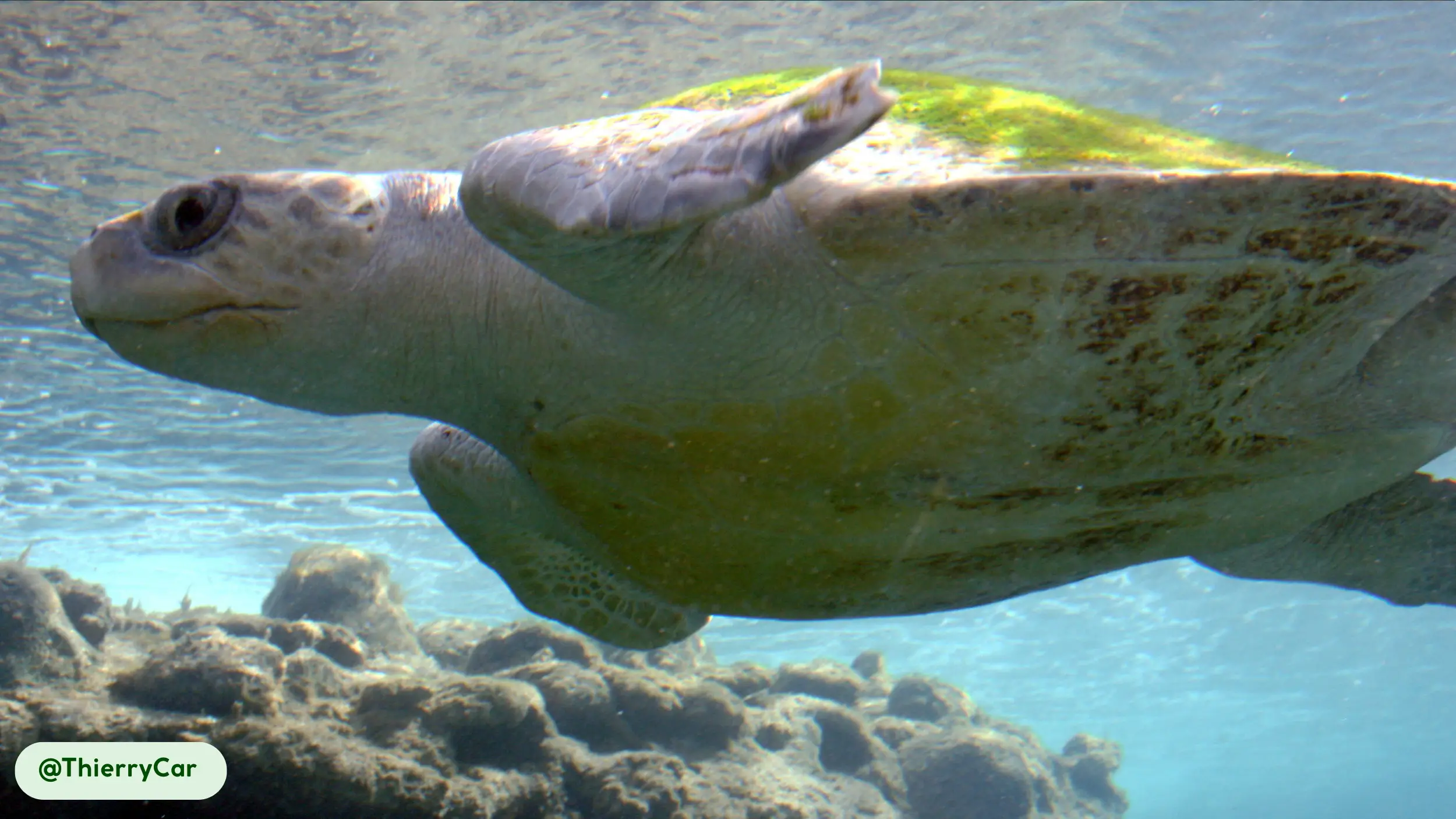
These behaviors, including their feeding habits and migrations, are all geared toward survival and reproduction. The next step is to examine the process that allows the species to continue its life cycle.
How Do Olive Ridley Sea Turtles Reproduce?
Olive Ridley sea turtles are oviparous, meaning they lay eggs on land, a common reproductive strategy among reptiles. Mating occurs offshore, a few months before the nesting season, with males exhibiting courtship behaviors that can include following females and biting their neck flippers [14]. After copulation, the female stores the sperm for an extended period, allowing her to lay multiple clutches of eggs from a single mating [14].
A female Olive Ridley typically lays between 80 and 120 eggs per clutch, and a single turtle may nest up to three times per season [14]. She digs a bottle-shaped nest chamber in the sand, deposits her eggs, and then covers it to hide her nest from predators.
The eggs incubate for approximately 45 to 60 days, with the exact duration dependent on the nest’s temperature and humidity [1]. The female provides no parental care after laying her eggs, leaving the hatchlings to fend for themselves upon emergence from the nest [11].
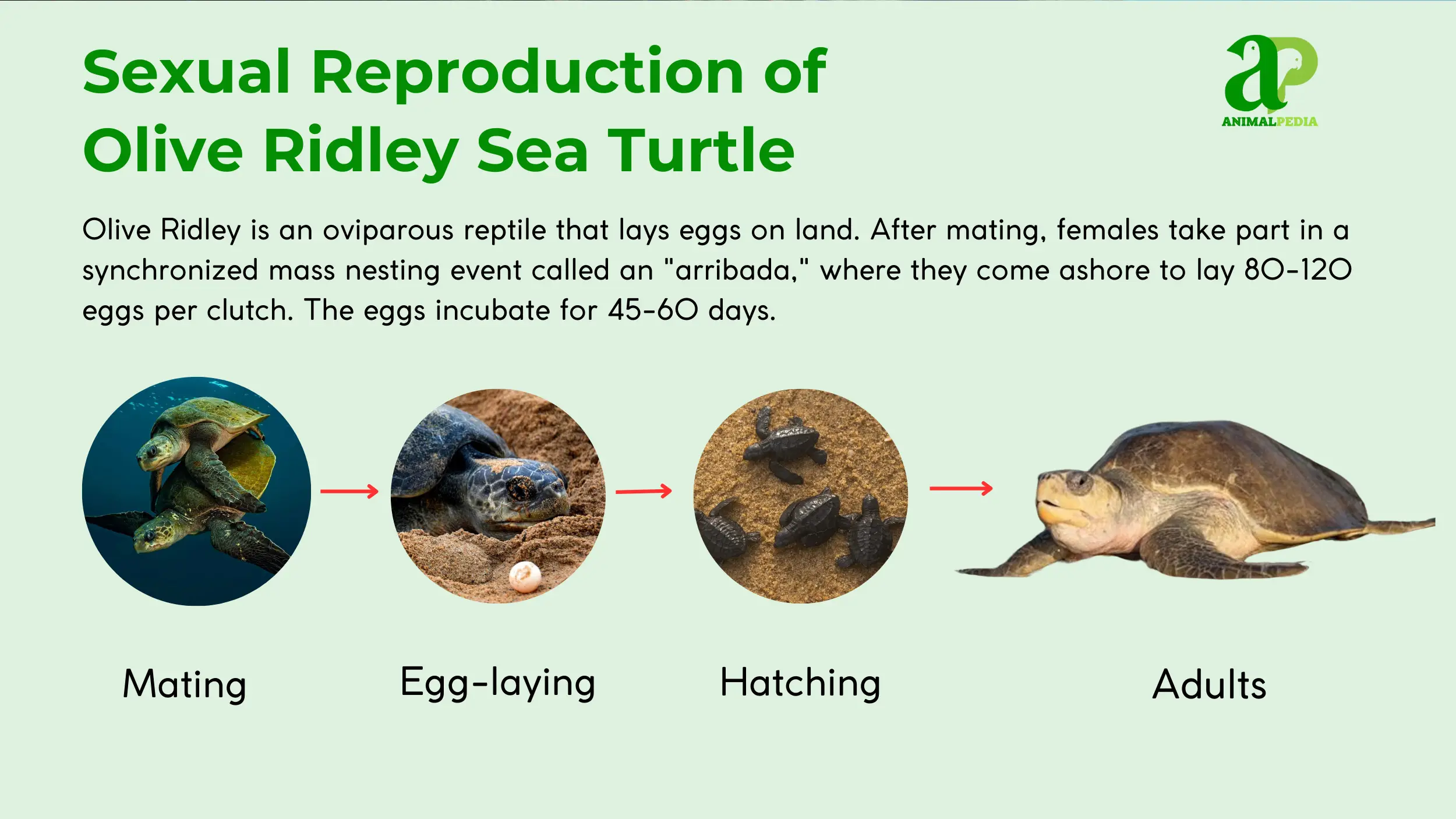
The ability to reproduce is central to the species’ survival. But what happens after the eggs are laid? The longevity of these turtles is a complex topic influenced by many factors.
How Long Do Olive Ridley Sea Turtles Live?
The average lifespan of an Olive Ridley sea turtle in the wild is difficult to determine with certainty, but it is estimated to be over 50 years [6]. In controlled environments, such as aquariums, their lifespan can vary depending on care, diet, and habitat quality [11]. A turtle’s longevity is impacted by a multitude of factors, including the high predation rates faced by hatchlings and juveniles, which contribute to a low survival rate to adulthood [10].
Olive Ridley turtles reach sexual maturity at approximately 15 years of age [11]. Their journey to adulthood is fraught with challenges, as they must survive environmental threats and human-induced impacts. Threats to their longevity include entanglement in fishing gear, ingestion of plastic debris, and habitat loss due to coastal development, all of which compromise their ability to forage and reproduce [5].
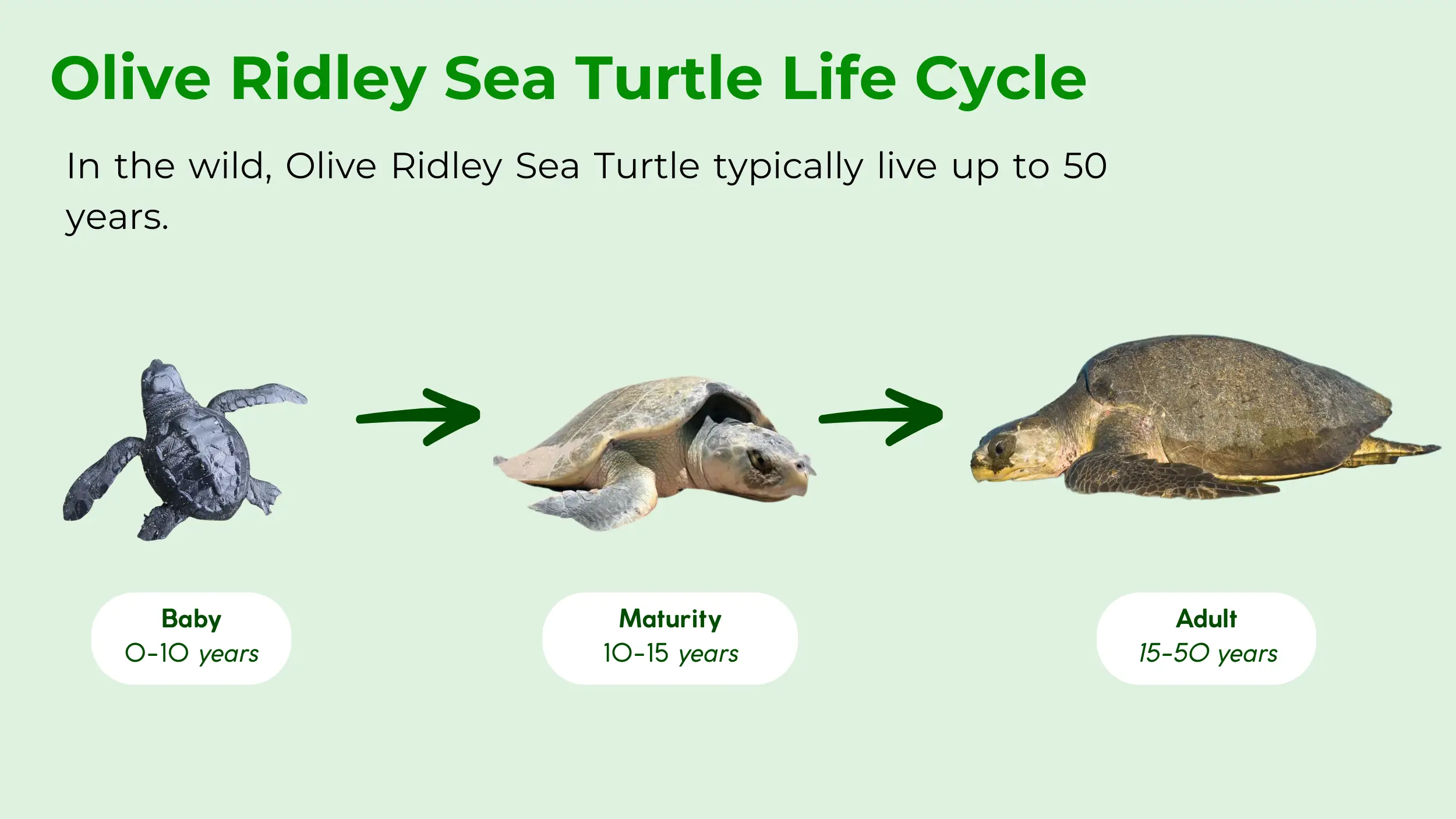
The long life of a sea turtle is full of challenges, but it also offers the turtle an opportunity to contribute to its ecosystem. The species offers a remarkable array of benefits to both the environment and human communities.
Are Olive Ridley Sea Turtles Beneficial to Humans?
Olive Ridley sea turtles are highly beneficial to humans, primarily through their significant role in maintaining the health of marine and coastal ecosystems. As foragers, they help regulate the populations of prey species, such as jellyfish and shrimp, which contributes to the overall stability of the food web [2, 18]. Their nesting behavior on beaches is also beneficial, as the eggs and hatchlings can become food for other animals, and the turtles’ digging activities contribute to the health of beach and dune vegetation [1].
In addition to their ecological value, the species holds cultural significance in regions where it nests. For example, in some parts of India, the arrival of Olive Ridleys for their mass nesting events is a celebrated natural phenomenon, symbolizing renewal and a connection to the marine environment [4].
The turtles also contribute to ecotourism, with people traveling from around the world to witness the spectacular arribada, which provides economic benefits to local communities [6]. While these turtles provide great benefits, they are also facing significant threats from human activities. Their status as a vulnerable species is a call for us to protect them and their habitats.
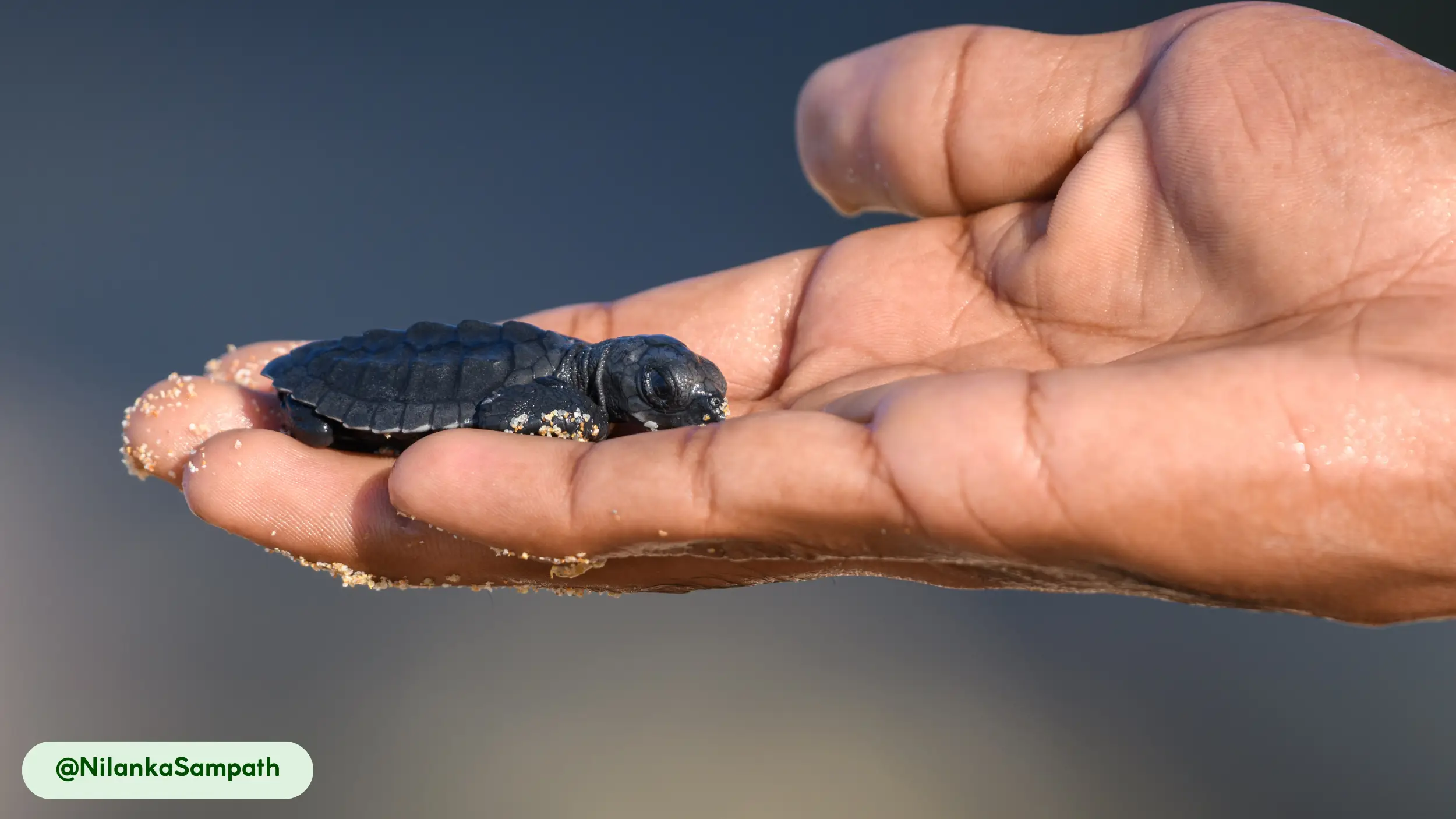
Are Olive Ridley Sea Turtles Endangered?
The Olive Ridley sea turtle is classified as a Vulnerable species globally on the IUCN Red List [16]. This status indicates that the species faces a high risk of extinction in the wild. While some populations are stable, others are declining due to various threats [6]. The primary threats to their survival are bycatch in commercial fisheries, particularly from gill nets and trawling, as well as the loss of nesting habitats [5].
Other significant threats include marine pollution, where plastic debris is often mistaken for food, and illegal egg and meat harvesting in certain regions [11]. Conservation efforts focus on protecting nesting beaches, reducing bycatch through the use of Turtle Excluder Devices (TEDs), and promoting awareness through public education [6].
Individuals can help by reducing their use of single-use plastics, supporting sustainable fishing practices, and donating to conservation organizations that work to protect sea turtles and their habitats.
Beyond their vulnerable status, these turtles hold a host of surprising characteristics that reveal their resilience and unique place in the marine world. Their behaviors and biology are full of unexpected details that make them an amazing subject of study.
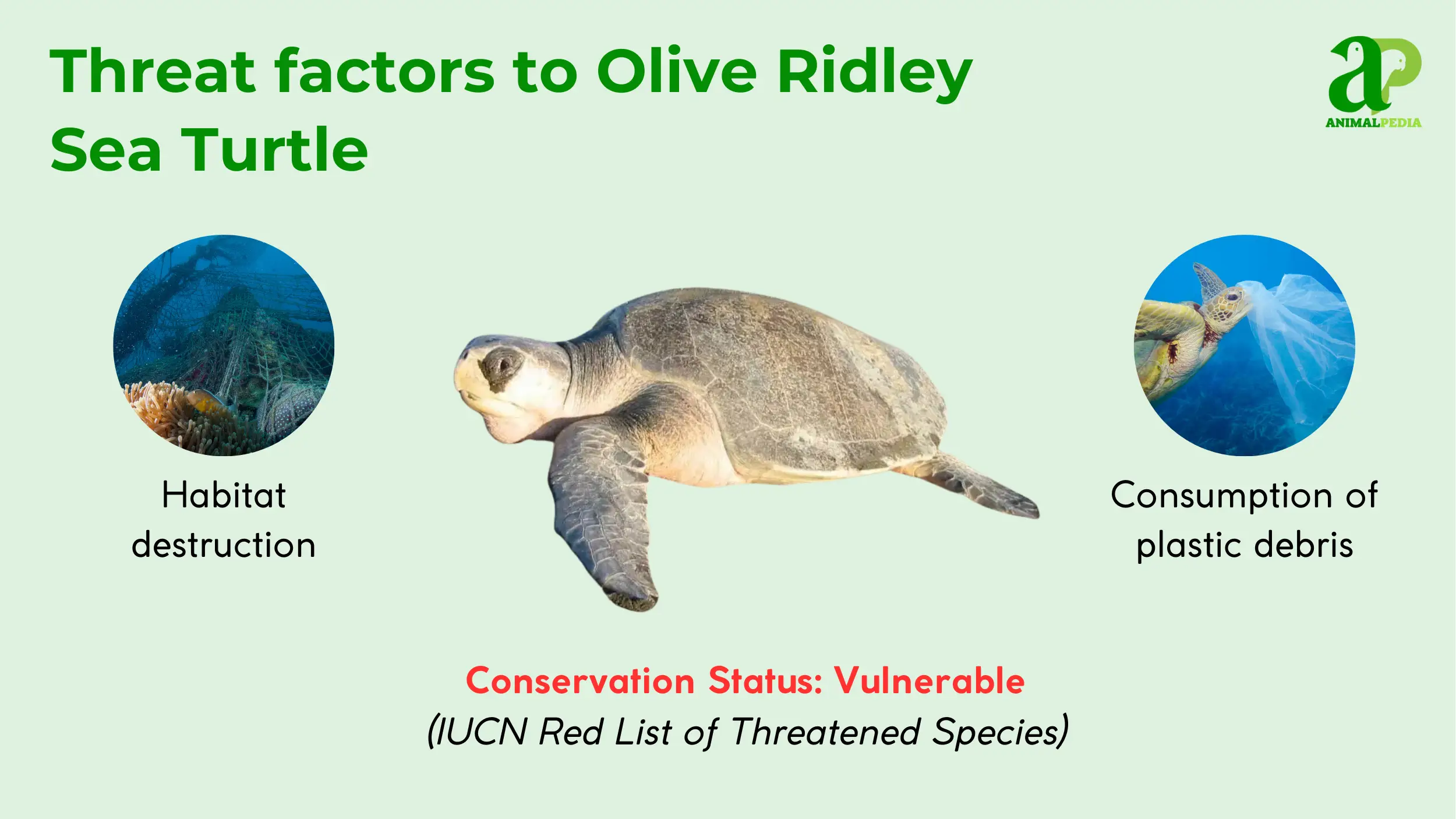
Frequently Asked Questions About Olive Ridley Sea Turtles
Why are olive ridley turtles so important?
Olive Ridley sea turtles play a crucial role as engineers in the marine ecosystem. They help maintain the health of coral reefs and seagrass beds by regulating prey populations, which contributes to the stability of the entire marine food web.
Where is the world’s largest rookery of olive ridley turtles situated?
The world’s largest rookery of Olive Ridley sea turtles is located at Gahirmatha Beach in the state of Odisha, India [15]. This site is protected as part of the Gahirmatha Marine Sanctuary.
Conclusion
The Olive Ridley sea turtle is a species renowned for its resilience and biological complexity. From their small size to their spectacular arribada events, these creatures play a vital role in marine ecosystems. Their extensive migrations and unique nesting behaviors are a testament to their deep connection with the world’s oceans.
At Animal Pedia, our mission is to illuminate the intricate lives of these animals and foster a deeper appreciation for the planet’s diverse fauna. We invite you to continue exploring the world of animals —from the smallest reptiles to the largest mammals —through our comprehensive, interactive digital encyclopedia.

